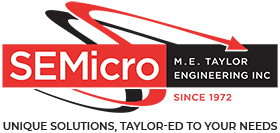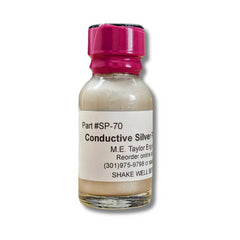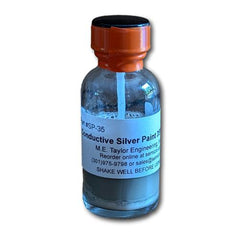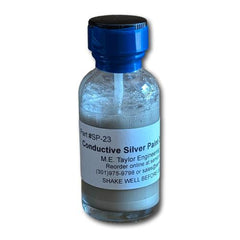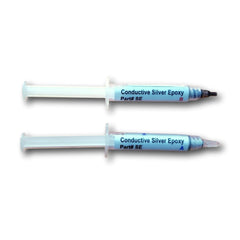
SHAKE IT UP WITH OUR NEW 7000RPM VOLTEX MIXER!

CONDUCTIVE INK/PAINT
Our highest concentration of Silver Paint: >70%! New Formulation sticks well to glass!
SP-70+ is a low viscosity, high solids, >70% silver-filled ink designed originally for high speed gravure and rotary screen printing processes. It is also suitable for spray and coating applications. SP-70+ dries to a hard, durable and very flexible film and has excellent conductivity – especially in very thin traces down to 5 to 6 μm dried thickness. SP-70+ is designed to dry very quickly, and has excellent adhesion to a wide variety of plastic and metal substrates. It also adheres well to glass. Applications for SP-70+ include RFID and cell phone antennas, medical EEG and EKG sensors and EMI/RFI shielding applications. Non-hazardous and ships anywhere with no restrictions.
Properties:
| Appearance | Silver Liquid |
| Viscosity (#5 RV Spindle, 20 rpm, 25 deg C) |
1,500 cps |
| Shelf Life | 6 Months |
| Total % NV Solids | 70+% |
Physical Properties After Cure (0.001" Thick Film):
| Hegman Gage | <10.0 μ |
| Volume Resistivity (ref. ASTM D-257) After 1 Crease, 1 mil Dry Film On 5 mil Mylar |
0.0002 Ohm-cm <0.0005 Ohm-cm |
| Surface Resistivity (ref. ASTM D-257) | <0.025 Ohm/Sq |
| Pencil Hardness (ref. ASTM D3363-05) | 2H minimum |
Application Methods:
SP-70+ can be applied by all conventional methods including spraying, dip, roll or knife over roll coating and curtain coating. When used as to saturate foam or other porous materials in a dip process, it is recommended that excess material be squeezed from the material before oven drying using nip rollers. After application, oven drying is recommended. Depending on the film thickness, drying can be accomplished in less than two minutes at temperatures above 250°F with adequate air flow. Completeness of drying can be verified by measuring the electrical surface resistivity of dried material using a box electrode or point electrodes hooked up to a multimeter. After initial drying, measure surface resistivity. Dry the material for another cycle and measure resistivity once more. If the drop in resistivity between the first and second drying cycle is less than 10%, drying can be considered complete after the first cycle. For more critical applications or where outgassing may be a concern the difference in resistivity between the two drying cycles should be less than 5%, and consideration should be given to post-baking the material in batch ovens for 30 to 60 minutes at 250 – 300°F.
If oven drying is not appropriate for the substrate being coated, it may take several hours for the SP-70+ to dry, depending on coating thickness. Again, check the resistivity of the coating using a multimeter when the SP-70+ appears to be dry. Compare this value to the value obtained several hours later and if the drop in resistivity is less than 10%, drying can be considered complete after the first measurement. This process will need to be repeated for different coating thicknesses, substrates or application methods to determine the proper air-drying time for a specific application.
